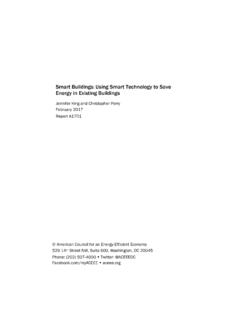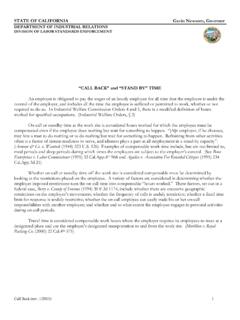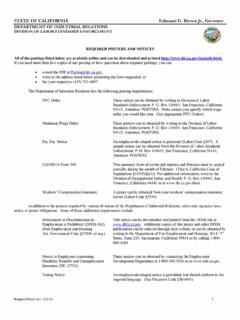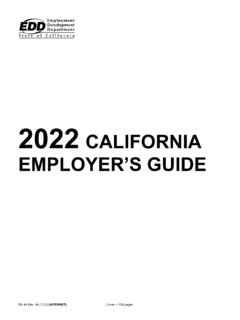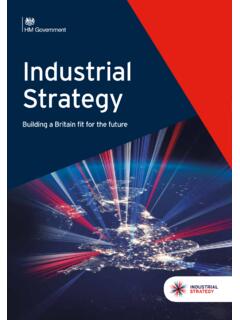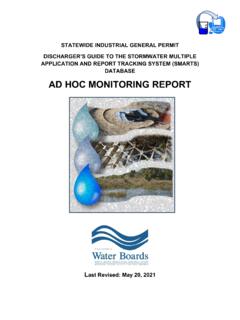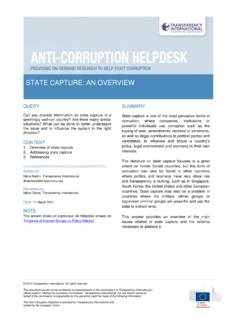Transcription of Industrial Oxygen: Its Use and Generation
1 Industrial oxygen : Its Generation and Use Prakash Rao and Michael Muller, Center for Advanced Energy Systems, Rutgers, the State University of New Jersey ABSTRACT This paper will look at the Industrial uses for oxygen . It will categorize oxygen using processes into: 1) the purpose of oxygen in the process and 2) the effect oxygen enrichment has on the overall process. The paper will also look at four methods of producing oxygen : cryogenics, pressure swing absorption, membrane filter technology and electrolysis. It will compare each against one another in categories such as first time costs, running costs, percent oxygen enrichment attainable, and by-product capability. Furthermore, the paper will then select the appropriate process for each industry discussed.
2 This paper is intended to address the above issues in such a way that a facility manager would be able to make an educated decision on whether or not to consider creating/using oxygen enhanced air in his/her process as well as which technology would be best suited for his/her process. Introduction Role of oxygen in Combustion Atmospheric air is comprised of 21% O2, 78% N2 and the remaining 1% is mostly argon and CO2. Air is a chief constituent in combustion. In the combustion process, the oxygen in air is broken down to make carbon dioxide, water, and energy. Nitrogen is not an essential part of the process. In fact, nitrogen in air has negative impacts on combustion processes. Nitrogen gets heated by the reaction to very high combustion temperatures and is carried out through the flue.
3 Essentially, the heated nitrogen leaving the flue is like throwing fuel out of the stack. Also, during the combustion process nitrogen in the air and fuel will break down to form harmful NOx gasses. Combustion processes can be improved by lowering the amount of nitrogen used in the combustion air and increasing the amount of oxygen . The benefits include: higher combustion efficiencies due to a drop in heat loss (as a result of lower mass flow rates) out of the stack, lower NOx emissions, and higher process temperatures. Role of oxygen in Gasification Gasification is the process by which coal or another carbon based fuel is transformed into a synthesis gas ( syn gas ). This syn gas is made up of mostly CO and H2.
4 This gas can be used to produce electricity or steam. Gasification has many values, including the ability to use low BTU fuels for energy production, easier carbon dioxide capture as compared to traditional sequestration methods, and the ability to produce hydrogen gas. Gasification is carried out in steps. First, the fuel is ground up into slurry. Next, the fuel is pyrolized in an oxygen starved environment. This turns the majority of the carbon into a gas. The next step is to add oxygen or air ( direct gasification ) or steam ( in-direct gasification ) at high temperatures to form carbon monoxide and hydrogen. This is the syn gas that can be used 6-124 2007 ACEEE Summer Study on Energy Efficiency in Industryfor a variety of energy producing systems.
5 Before it is used, however, the gas may need to undergo more processing, such as removing particulates or cooling, depending on its end use. Air can be separated into its constituents using a variety of techniques. This paper will address cryogenic, pressure swing adsorption, membrane technology and by-product methods of O2 Generation . Each air separation technology produces oxygen at different purities, pressures, and volumetric flow rates. Furthermore, each technology has different running costs. One air separation method is not any better across all industries than any other technique. Depending on the needs of process, one air separation technique will be more beneficial than others. This paper will look at the glass, gasification and gas-to-liquid industries, with a focus on gasification, their oxygen needs and the effect that oxygen enrichment will have on the process.
6 Current research in metals oxidation will also be addressed. Description of Technologies Cryogenic Separation Cryogenic air separation units (ASU) is an old process used to produce high purity oxygen or nitrogen at high volumes. The process was first developed by Carl Von Linde in 1895 and it remains pretty much the same today. Cryogenics is also the chief method by which liquid oxygen can be produced. The technology is centered on the fact that each of air s constituents has different boiling points. The idea behind the process is to lower the temperature of the air such that nitrogen and oxygen separate based on their boiling points. This occurs at around If higher purity oxygen or liquid oxygen is required, further distillation is required.
7 For liquid oxygen , nitrogen is used as the heat transfer fluid to further cool the oxygen . Cryogenic separation is most effective when any of the three criteria need to be met: high purity oxygen is required (> ), high volumes of oxygen are required ( 102 tons of oxygen /day), or high pressure oxygen is required. Cryogenic air separators take more than an hour to start up. Additionally, since cryogenics can produce such a high purity of oxygen , the waste nitrogen stream is of a usable quality [Smith 2001]. This can add significant financial benefits to a process integrated with a cryogenic ASU. Pressure Swing Adsorption Pressure swing adsorbers (PSA) are a much newer technology as compared to cryogenic ASU. PSA devices take atmospheric air into a pressurized tank.
8 Inside the tank are zeolites. Zeolites, under pressure, have the ability to deform and create a dipole. Depending on the zeolite chosen, this dipole allows for the collection of nitrogen, but allows oxygen to pass. For oxygen enrichment, the PSA is generally pressurized to a minimum of atm. After a certain volume of air has been separated, the zeolite will become saturated with nitrogen. At this point, it needs to be regenerated. This is done by dropping the pressure of the tank back to atmospheric pressure, thus returning the zeolite to its original polarity. This liberates the nitrogen. Vacuum Pressure Swing Adsorbers (VPSA) lower the pressure in the tank to sub atmospheric values, thus improving the regeneration process. In both processes, while one tank is regenerating, another tank is usually charging.
9 This allows for a continuous production of oxygen . PSA devices are best suited for processes that do not require extremely high purities of oxygen (<95%). While PSAs can achieve as high as , the cost associated with going above 6-125 2007 ACEEE Summer Study on Energy Efficiency in in a PSA device rises tremendously. Furthermore, PSA devices are best suited for small volumes of oxygen production, typically on the order of 101 tons/day. Since the output of oxygen is largely controlled by the bed size in the PSA systems, costs rise linearly when higher volumes of oxygen are required. PSA devices take a few minutes for start-up [Smith 2001]. A mid-sized pressure swing adsorbers running costs are shown below. The data is for an Oxair Model OXT-B14 adsorber.
10 O2 output Compressor Power Chiller Power Power Cost Foot Print 400 Nm3 or tons/day 400 HP or 276 KW 150 HP or 80 KW KW/ Nm3 190 m2 Also, the usability of by-product nitrogen in PSA systems is limited because the nitrogen will have significant levels of oxygen . [Smith 2001]. Membrane Technology Conventional membrane technology involves passing air over a membrane filter. The filter will allow fast gasses to pass and slow gasses will stay. oxygen is considered a fast gas and nitrogen and argon are considered slow gasses. Varying levels of purity can be achieved by varying the time that the gas spends undergoing filtration. Previous membrane technology could only produce purity levels of less than 50%. Membrane technology has quick start-up times and operates at near ambient conditions.
